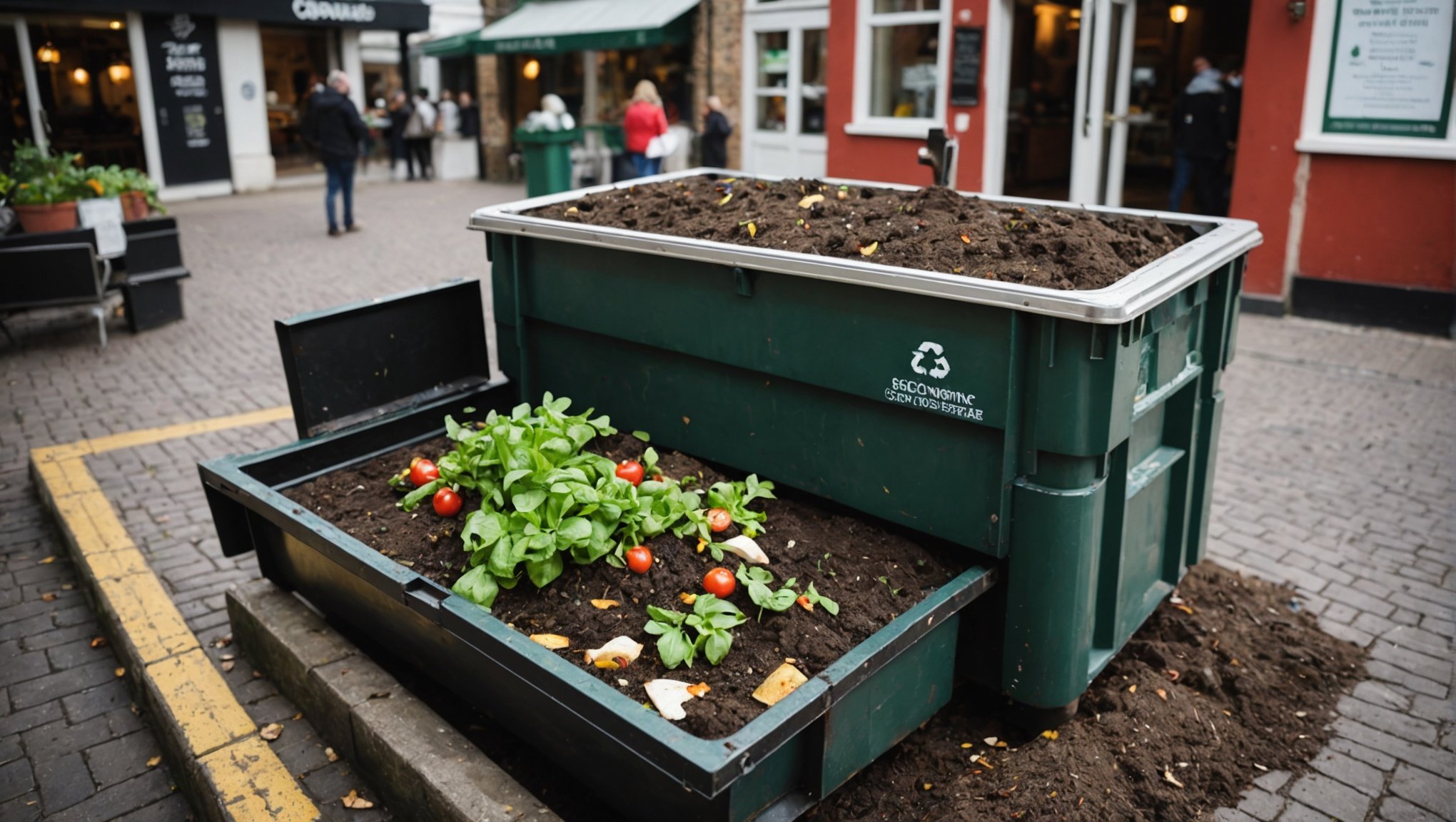Transform Your Restaurant: A Step-by-Step Guide to Launching an Organic Waste Composting System
In the culinary world, the phrase “waste not, want not” has never been more pertinent. With the increasing awareness of environmental sustainability, restaurants are under growing pressure to manage their waste more effectively. One of the most impactful ways to do this is by implementing an organic waste composting system. Here’s a comprehensive guide to help you transform your restaurant into an eco-friendly hub.
Understanding the Importance of Organic Waste Composting
Before diving into the nitty-gritty of setting up a composting system, it’s crucial to understand why this practice is so vital.
Topic to read : Crafting the Perfect Family Menu: How Restaurants Can Delight Kids and Adults Alike
The Environmental Impact of Food Waste
Food waste is a significant problem globally, with approximately one-third of all food produced being wasted. This not only results in economic losses but also has a profound environmental impact. When food waste ends up in landfills, it decomposes anaerobically, producing methane, a potent greenhouse gas. By composting organic waste, restaurants can significantly reduce their environmental footprint.
Economic Benefits
Implementing a composting system can also have economic benefits for your business. By reducing the amount of waste sent to landfills, you can lower your waste disposal costs. Additionally, the compost produced can be used in your restaurant’s garden or sold to local farmers, generating additional revenue.
Topic to read : Eco-Friendly Nights: Strategies for Bars to Embrace Sustainability Without Dimming the Party Vibe
Assessing Your Restaurant’s Waste Management Needs
Conducting a Waste Audit
The first step in launching an organic waste composting system is to conduct a thorough waste audit. This involves analyzing the types and quantities of waste your restaurant generates. Here are some key areas to focus on:
- Food Scraps: Identify the types of food waste generated, such as vegetable peels, fruit scraps, and leftover food.
- Packaging Waste: Assess the amount of packaging materials used, including plastic, paper, and glass.
- Cooking Oil Waste: Determine how much cooking oil and grease are generated and how they are currently disposed of.
Identifying Opportunities for Reduction
A waste audit will help you identify areas where you can reduce waste. Here are some strategies to consider:
- Portion Control: Implementing portion control measures can significantly reduce the amount of food waste generated.
- Inventory Management: Ensuring that you only order what is necessary for immediate use can help minimize waste.
- Creative Use of Leftovers: Encourage your chefs to find creative ways to use leftovers, such as making stock from vegetable scraps or repurposing overripe fruits in desserts or smoothies.
Setting Up Your Composting System
Choosing the Right Composting Method
There are several composting methods to choose from, each with its own advantages and disadvantages.
- Aerobic Composting: This method involves decomposing organic waste in the presence of oxygen. It is faster and produces less odor than anaerobic composting.
- Anaerobic Composting: This method involves decomposing organic waste without oxygen. It is often used in large-scale industrial settings but can produce more odor and methane.
- Mechanical Composting: This method uses machines to accelerate the composting process. Companies like TMK offer commercial and household composting machines that can turn organic waste into compost in just 24 hours.
Selecting the Right Equipment and Bins
Once you’ve chosen your composting method, you’ll need to select the right equipment and bins.
- Composting Bins: Choose bins that are specifically designed for composting and have adequate ventilation to prevent odor buildup.
- Food Waste Collection Bins: Ensure that you have separate bins for collecting food scraps and other organic materials. These bins should be easily accessible and clearly labeled.
- Mechanical Composters: If you opt for mechanical composting, ensure that the machine is suitable for your restaurant’s size and waste generation.
Implementing Practical Composting Practices
Training Staff and Engaging Customers
Training your staff and engaging your customers are crucial steps in the success of your composting system.
- Staff Training: Educate your staff on the importance of composting, how to separate organic waste, and how to maintain the composting bins. Regular training sessions can help ensure that everyone is on board with the new practices.
- Customer Engagement: Inform your customers about your sustainability efforts through menu descriptions, signage, and digital communication channels. Encourage them to participate by offering incentives such as discounts for bringing reusable containers or participating in composting programs.
Sustainable Menu Planning
Designing a sustainable menu can significantly reduce waste and support your composting efforts.
- Seasonal and Local Ingredients: Use seasonal and locally-sourced ingredients to reduce the carbon footprint associated with long-distance transportation.
- Whole Ingredient Use: Plan menus that utilize whole ingredients, ensuring that every part of the produce and protein is used efficiently. This not only minimizes waste but also creates unique and flavorful dishes.
Managing and Maintaining Your Composting System
Regular Maintenance
Regular maintenance is essential to ensure that your composting system runs smoothly.
- Monitoring Moisture and Temperature: Ensure that the compost pile has the right balance of moisture and temperature to facilitate decomposition.
- Turning the Compost: Regularly turn the compost to maintain oxygen levels and prevent odor buildup.
- Pest Control: Keep an eye out for pests and take measures to prevent infestations.
Compliance with Regulations
Ensure that your composting system complies with local and international environmental regulations.
- Waste Disposal Regulations: Familiarize yourself with local regulations regarding waste disposal and composting.
- Health and Safety Standards: Ensure that your composting practices meet health and safety standards to prevent contamination and other hazards.
Benefits and Success Stories
Economic and Environmental Benefits
Implementing an organic waste composting system can have numerous economic and environmental benefits.
- Cost Savings: Reduce waste disposal costs and generate revenue from selling compost.
- Environmental Impact: Significantly reduce greenhouse gas emissions and the amount of waste sent to landfills.
Success Stories
Several restaurants and businesses have successfully implemented composting systems, showcasing the feasibility and benefits of such practices.
- New York City’s “Make Food, Not Waste” Restaurant Week: This initiative involved top New York City restaurants using Mill’s food recycler to transform food scraps into nutrient-rich compost or feedstock. The campaign highlighted the potential of zero-waste cooking and the importance of sustainability in the culinary industry.
Practical Tips and Tools
Detailed Checklist for Implementing a Composting System
Here is a detailed checklist to help you get started:
- Conduct a Waste Audit
- Identify types and quantities of organic waste
- Assess packaging and cooking oil waste
- Choose the Right Composting Method
- Aerobic, anaerobic, or mechanical composting
- Select the Right Equipment and Bins
- Composting bins with adequate ventilation
- Food waste collection bins
- Mechanical composters if necessary
- Train Staff and Engage Customers
- Educate staff on composting practices
- Inform customers about sustainability efforts
- Design a Sustainable Menu
- Use seasonal and locally-sourced ingredients
- Utilize whole ingredients efficiently
- Regular Maintenance
- Monitor moisture and temperature
- Turn the compost regularly
- Control pests
- Ensure Compliance with Regulations
- Familiarize yourself with local waste disposal regulations
- Meet health and safety standards
Comparative Table: Composting Methods
| Composting Method | Advantages | Disadvantages | Suitability |
|---|---|---|---|
| Aerobic Composting | Faster decomposition, less odor | Requires regular turning | Small to medium-sized restaurants |
| Anaerobic Composting | Can be used for large quantities | Produces more odor and methane | Large-scale industrial settings |
| Mechanical Composting | Accelerates decomposition process | Higher initial cost | Commercial and household use |
Quotes from Industry Experts
- Camari Mick, Executive Pastry Chef at The Musket Room: “As a chef, we need to bear some responsibility on what it means to eat and be sustainable. When we create and develop menus, we should always be forward thinking in how we can use 100% of a product.”
- Dan Kluger, Chef/Owner of Greywind and Loring Place: “We wanted to challenge ourselves to take our commitment to reducing waste even further. The idea was to highlight dishes that would teach us how much potential there is in ingredients that would normally be discarded.”
- Fidel Caballero, Chef/Owner of Corima: “If something cannot be used fresh, how can we preserve, dehydrate, pickle, or ferment it to maximize flavor?”
Launching an organic waste composting system in your restaurant is a significant step towards a more sustainable future. By understanding the importance of composting, assessing your waste management needs, setting up the right system, and maintaining it properly, you can reduce your environmental impact, save costs, and enhance your business’s reputation.
Remember, every small step counts, and the collective effort of restaurants embracing sustainability can lead to a substantial positive change. As Chef Camari Mick aptly puts it, “The time for change is now.” So, take the first step today and transform your restaurant into an eco-friendly haven that not only delights your customers but also protects our planet.






